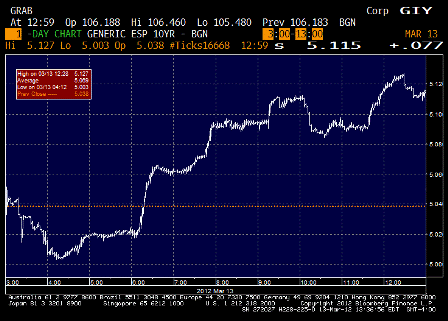Note how ‘currency users’ are limited to relatively low levels of debt by markets:
Valencia’s total outstanding debt at the end of 2011 was EUR20.76 billion, equal to around 20% of its GDP.
Spain ran up it’s current national debt as a currency issuer when it not only didn’t matter financially with regards to funding and solvency, but it was, for all practical purposes, a requirement to accommodate non govt savings desires at desired levels of output and employment.
Spain, and the rest of the former currency issuers, then waltzed into the euro zone arrangements as currency users who all agreed to keep the same debt levels they had accumulated as currency issuers, rendering the euro arrangements ‘an accident waiting to happen’ from the get go.
Spain’s Valencia Struggles To Repay Debt
By Jonathan House and Art Patnaude
May 4 (Dow Jones) — Spain’s financially troubled Valencia region had to pay a punitive interest rate to roll over a short-term debt Friday, raising new concerns about its solvency and prompting the regional government to offer assurances it can avoid a default.
“We have covered our refinancing needs through June and we are planning on meeting our commitments,” a Valencia spokesman said.
Valencia had to offer institutional investors a 7% interest rate to roll over a EUR500 million debt for six months on Friday, a new sign of a deepening financial crisis for the regions that control over one third of spending in highly decentralized Spain. That’s more than four times what the Spain’s central government offered at its last auction of six-month treasury bills.
With a long history of overspending, Spain’s regions have moved to the center of the country’s fiscal crisis. As Prime Minister Mariano Rajoy tries to close yawning budget gaps at all levels of government and return the ailing local economy to growth, his government is scrambling to make sure the regions meet their financial obligations while reining in expenditures.
Spain had a general government budget deficit equal to 8.5% of gross domestic product in 2011, far in excess of the 6%-of-GDP target it had committed to with the European Union and international investors. Much of the overrun was the fault of the regions.
In recent months, the fiscally frail regions are facing increasing difficulty in financing themselves. International investors are steering clear. “There’s still a great deal of reluctance from institutional investors to get involved in Spain. The uncertainties are a bit too big,” said Elisabeth Afseth, fixed-income analyst at Investec Bank in London.
Valencia, on Spain’s Mediterranean coast, is one of the most troubled of its 17 regions. With its hundreds of kilometers of beachfront properties, it is ground zero for the collapse of the Spain’s housing industry, which has punched a large hole in national tax revenue and sent the economy into a long slump. The housing bust, coupled with years of high spending, has made Valencia one of the most indebted regions.
Valencia’s total outstanding debt at the end of 2011 was EUR20.76 billion, equal to around 20% of its GDP.
Late last year, Moody’s Investor Service downgraded Valencia’s credit to junk status and the central government had to advance Valencia some of its regular financing to prevent it from defaulting on a EUR123 million debt to Deutsche Bank AG (DB). In Spain, most tax revenue is collected by the central government.
Since then, Rajoy’s government, which came to power in December, has strengthened financial support for the regions and said it won’t let any default on their obligations. It set up an EUR10 billion credit facility they can draw on to refinance their debts and is offering EUR35 billion worth of loans to help them pay off debts to suppliers.
The Valencia spokesman said his region has received EUR2.69 billion from the credit facility that will allow it to meet all its debt obligations in the first half of the year. In addition, Valencia and other regions are pushing hard to get Madrid agree to guarantee their debts, which should help lower borrowing costs, he added.
Valencia has to refinance EUR4.5 billion worth of debt this year.


